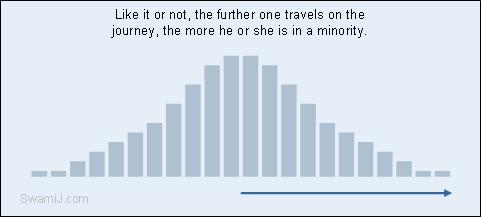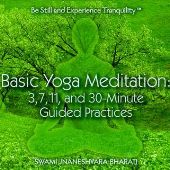|
|
About this SiteSee also: Welcome to SwamiJ.com, People of religion often speak of their founder or special person as himself being, being the representative of, or having experienced that which is described as indescribable, ineffable, transcendent or immanent, often thinking of their person as either the only one, or the final one in the history of humanity with such experience. The path of Yoga is not one of mere belief, but rather is a systematic way for each person to realize in direct experience his or her own unity with that infinite essence which is spoken of with so many names. The Sanskrit word "Yoga" means "union," which is the union of the individual self or soul with the nondual, absolute reality. While Yoga can be described in different ways, it has to do with the realization through direct experience of the preexisting union between Atman and Brahman, Jivatman and Paramatman, and Shiva and Shakti, or the realization of Purusha standing alone as separate from Prakriti. The word "Yoga" is virtually one and the same with the word "Samadhi," the deep, transcendent realization of the highest truth or reality. Each of these Sanskrit terms relates to the subtleties of Yoga as described in the various paths of Yoga, Vedanta, and Tantra. It is with great compassion for the few who share the authentic goals of traditional Yoga that I have created, and continue to revise and expand this website. I say "compassion" because I know that you are most likely in a minority amongst your family, friends, coworkers and community. You are most likely in a minority within the church or other religious group in which you were raised. You are most likely in a minority amongst even people who claim to be practicing Yoga in our modern world. To move forward, seeking the highest Truth or Reality in the face of such opposition is worthy of compassion and support. It is my sincere wish that this website serves you in this way. This site is devoted to presenting the ancient Self-Realiation path of the Tradition of the Himalayan masters in simple, understandable and beneficial ways, while not compromising quality or depth. The practices include Yoga meditation of the Yoga Sutras, contemplation of Advaita Vedanta, and purely internal kundalini-shakti practices of Samaya Sri Vidya Tantra. These teachings of the sages of the Himalayas systematically lead one to the highest Realization of the center of consciousness. Most of the articles on this site came as a result of questions from people asking me for simple, straightforward, practical explanations about principles and practices of meditation. When the site was originally quite "empty" of articles, some question would come, and this would lead to writing an article or creating a graphic image to try to clarify that point. While simple explanations seem to sometimes grow into something more complicated, it is hoped that the articles here are presented in easy to understand language. This is said with a smile, as I truly find it humorous that such simple principles take so very many words, and that we end up with the appearance of complexity. All we can do is cry, get frustrated, or laugh, and the laughter seems to be the more useful path. You will notice a common pattern among many of the articles, and that is to describe the universal inner process, which is systematic in nature. From outer to inner, through the levels and layers of our being, attention moves to the subtler and subtler aspects, finally leading the seeker to the pure, eternal center of consciousness, by whatever name you choose to call that center. Many of the articles describe this same process using different language and metaphors, with each adding a slightly different perspective that might make that underlying process more clear. It is my sincere belief and experience that these principles and practices are universal, non-religious and non-sectarian. Admittedly, not all people agree with this. However, this is the stance from which I share, and say unequivocally that these principles and practices are applicable and useful to all people. This is not to say that all cultures and religions are one and the same. If anyone does want to convert to some other religion, they will have to go elsewhere. Not only do I not do this, I do not even know how to do this, as I do not know the conversion rituals, rites or vows of any of the religions. I do not claim ownership over any of the principles or practices described here, although the wording itself falls under the domain of copyright laws*. There is no intent or desire whatsoever to profess or proffer any Swami Jnaneshvara system of Yoga. We already have far too much of that in our modern world. These ancient teachings are universal and available to the whole of humanity. It is only by the gift of my teacher and tradition that direct experience has been there sufficiently that I was instructed to share with others. It is from that, that these principles and practices are shared. The relationship between student and teacher is a very personal one that is best done in face-to-face contact. I hope you glean much personally useful information from the articles on this website, but they are not meant to replace such personal contact. I wish for you to find the teacher who is just right for you. However, there is no intent here to establish student-teacher relationships via internet. Some others may do that, but I do not personally find this to be realistic. Simple questions of a general informational nature can be responded to by email, but I refrain from giving direct personal instructions through the medium of internet. Ultimately, the goal of even the external teacher is to lead the student to find the teacher within. May you find that teacher. The articles on the site are continuously being expanded and edited for ever increasing clarity. If you print out any of the articles or save them into your computer, please do remember to revisit from time to time to check for revisions. Above all, it is hoped that one thing is abundantly clear in these articles, and that is that the keys to direct experience of your own center of consciousness, by whatever name you choose to call that, are to practice, practice, practice. Please enjoy your visit to SwamiJ.com, and come back often. In loving service, Swami J
* The articles on the site are here in
the spirit of selfless service. No specific copyright privileges are
granted. While I don't grant any specific
copyright privileges, I would not voice objection to your printing a
minimal amount of text from articles for personal use or as classroom aids
(in alignment with the "fair use" provisions of copyright laws), as long as they are not
copied and distributed for commercial sale, and the source is referenced
as Swami Jnaneshvara Bharati and the www.SwamiJ.com website.
-------
|
|

